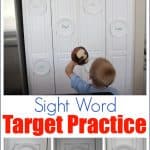Dolch Sight Words
Teaching sight words is one component of well-balanced literacy instruction. For many decades, we see a constant swing back in forth in the primary methods for reading instruction. On one end of the pendulum, we taught phonics as the “be all, end all” to teaching children to read. But phonics (especially in the English language) does not help a child with words that don’t play by the phonetic rules we teach. Eighty-seven percent of words follow predictable rules for English and spelling. This is still a large majority, but leaves 13% of words unable to be decoded or spelled based on the phonics principles we teach. Studies have also shown that students who learn using only phonics-based instruction read at a much slower rate than those taught using a blended approach.
On the other end of the pendulum, we abandoned the teaching of phonics altogether for a couple decades and just taught using a “whole reading approach”. This approach taught children to, in essence, memorize individual words or chunks of words. Seeing the word “cat” along with picture a picture of a cat over and over again would eventually allow students to memorize the word “cat” rather than decoding each individual sound /c/ /a/ /t/ and blending the sounds together to form the word. The whole reading approach was popular in the 80’s (when I was learning to read) and unfortunately has produced some very bad spellers.
Thanks to some very thorough research in the 90’s, we have gotten much wiser in our approach to reading and have come to the conclusion that a blended approach is best! The National Reading Panel found that there are five essential components that must be taught to develop effective readers. These skills are: phonemic awareness, phonics, reading fluency, vocabulary development, and reading comprehension.
One good aspect of the whole reading approach, however, is the idea of “sight words”. Sight words, also known as “high-frequency words”, are the most common words children will encounter when learning to read and often do not follow phonics rules. Because of this, I recommend helping your child memorize sight words that cannot be decoded using the basic phonics rules (I call these “cheater” words because they don’t play fair). The following Dolch Basic Sight Word List was compiled by Edward William Dolch in 1936. As you can see, many of the words on the list can be decoded (or sounded out). Words like “hot”, “in”, “it”, etc. will be easy to sound out once your child has learned to associate letters and sounds. Because of this, it is best to focus sight word practice with the words that cannot be decoded.
Download the Dolch Sight Words here.
Sight Word Activities:





